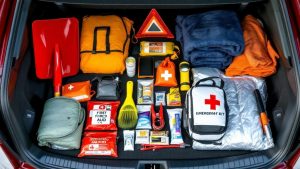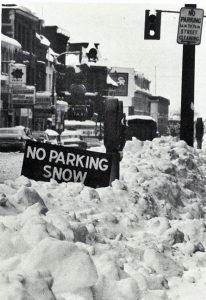The first real storm of winter never gives much warning. One minute, the sky is calm, the next, you’re watching snow whip past your windshield like streaks of light. In Eastern Ontario, that change can happen in the space of a single drive home. You might leave work under clear skies and be crawling through whiteouts by the time you reach your street. The line between getting home safely and getting stuck often comes down to how ready your car is.
Why winter readiness matters here
Eastern Ontario does not always ease into the season; it drops you straight into it. Lake Ontario pushes sudden squalls through the Kingston area, and the weather can flip from mild rain one hour to flurries or a full-on blizzard the next.

Temperatures swing sharply, freezing rain coats the 401, and what happens downtown can be entirely different a few kilometres north. Conditions can shift again once you get beyond Highway 7, where snowfall and plowing standards vary from one township to the next.
If you live, work, or shop here, cold and snow should not be a surprise, but something you plan for. The vehicle you drive becomes your link to everything else: work, family, school, and home.
Starting from the ground up
I switch to proper winter tires each fall and get a synthetic oil change at the same time. People sometimes ask if good all-seasons are enough. It depends on how far and where you drive, but the physics are the same for everyone. Rubber that grips at 20 degrees hardens in the cold. Winter tire compounds stay flexible below 7 degrees, and the difference shows on the first icy stop sign.
People sometimes ask if good all-seasons are enough. It depends on how far and where you drive, but the physics are the same for everyone. All-season tires are built for compromise. They harden in the cold and lose grip on ice, even when the tread looks fine. True winter tires are made with rubber compounds that stay flexible below seven degrees. They stop sooner, handle corners better, and give you control when it matters most. Ontario insurers recognize that advantage; most offer a five-percent discount when your policy lists winter tire.

Transport Canada testing shows that winter tires stop shorter and hold traction when all-seasons start to slide. They recommend installing four matching tires, not two, so the car stays balanced in corners and when braking. Book your changeover by mid-October before the first headlines about snow make every tire shop in Kingston impossible to reach.
Under the hood
Preparation starts where you can’t see. A battery that cranks fine in August can quit at minus ten. A quick load test in October is cheap insurance. If the reading is weak, replace it before you’re stranded in a parking lot. While you’re there, have your mechanic check belts, hoses, and coolant strength. A proper 50/50 antifreeze mix protects to around minus 37, which covers most Eastern Ontario nights.

Heat and defrost aren’t luxuries; they’re visibility systems. If airflow seems weak or the windows fog faster than they clear, get it serviced now. The same goes for wiper blades: replace them with winter versions and fill the reservoir with fluid rated to minus 40. Keep an extra jug where you can reach it if the trunk freezes shut, and keep a second snow brush or scraper near your home’s door. When snow piles against the car or the locks freeze, that simple backup saves you from digging through a drift just to get started.
Lighting matters too. Salt and spray dim lenses quickly, and you want every light: headlamps, brake lamps, and signals, working at full strength. Your being seen in blowing snow matters as much as seeing ahead.
The kit you hope you never need
Every Eastern Ontario driver should carry a winter emergency kit. Mine sits behind the driver’s seat, where I can reach it if the doors ice over. It includes a snow brush, an ice scraper, a small folding shovel, a set of booster cables, a flashlight, a reflective vest, and something for traction, such as sand or non-clumping kitty litter.

Add a blanket, spare gloves, hat, and boots, plus a few high-energy snacks and bottled water in an insulated sleeve. Toss in a power bank for your phone and a paper list of emergency numbers in case the battery dies. A small first-aid kit rounds it out.
If you drive rural routes north toward Sharbot Lake, west toward Napanee or Prince Edward County, or east toward Gananoque or along Highway 15, make sure to tell someone your route and expected return time. Cell coverage still drops out in spots between lakes and ridges, so having a backup plan is essential. Having a CAA membership is worth the cost. It may charge you a small annual fee, but not as much as a tow would cost if you don’t have it. CAA members can also use a range of travel and retail discounts that often pay back the membership on their own.
Driving when traction is scarce
Once you are on the road, assume traction is limited and drive with care. Accelerate gradually, steer smoothly, and brake early. Think of it as slow-motion driving, every movement measured and deliberate.
On snow-covered roads, use your common sense and reduce speed as the conditions require. There are days when a 20 percent slowdown is enough, and other times when you will find yourself crawling at half speed or less. Leave at least a five-second gap to the car ahead. When driving downhill, shift to a lower gear and let the car slow itself instead of riding the brakes. Keep the cruise control off; when the tires lose grip, it can try to speed up and make things worse.
If your vehicle has ABS, expect a pulsing brake pedal and keep steady pressure. If it does not, press and release the brakes gently to avoid locking the wheels. Never slam them. When a skid starts, ease off the gas and steer where you want the car to go.
Watch bridges and overpasses; they freeze first. In bright light, black ice looks like wet pavement. If the steering suddenly feels loose, that is your warning. Do not panic. Ease off, hold straight, and wait for the tires to grip again.
Kingston realities
Kingston’s mix of city, highway, and rural roads makes driving unpredictable. Downtown intersections become single-lane chutes once the snowbanks build up. The west end collects spray that freezes into brown glare on windshields. Out beyond Glenburnie and Verona, open stretches let snow drift across the road and hide the centre line completely.
If you are house-hunting in January, bring the same mindset as you would for any winter drive. Make sure your tires are the proper grade, your fuel tank is half full, and you have checked the forecast before heading out. Choosing a home here is not only about location. It is about learning to live comfortably through all four seasons. From neighbourhoods that get early plow priority to dwellings with garages and good drainage, local knowledge makes a real difference when the weather turns.

The cost of not preparing
A complete seasonal inspection might run a few hundred dollars, but one roadside tow in a snowstorm costs nearly that much. A weak battery or worn tires can easily turn into a damaged fender or worse. Preparation is not only about saving money. It is about keeping control when you need it most.
Winter driving affects everyone in this region: commuters, parents, students, and anyone who needs to get across town or out along the county roads. Eastern Ontario winters do not forgive shortcuts, but they reward preparation. The earlier you get ready, the calmer every trip feels.
FAQ
Do I really need snow tires in Ontario?
Yes. They are not legally required, but every safety test shows they outperform all-seasons once temperatures drop below seven degrees. They also qualify you for an insurance discount in Ontario.
When should I change my tires?
Plan for mid-October. By November, service shops are fully booked, and cold mornings can already freeze summer compounds.
What should be in a winter emergency kit?
A snow brush, scraper, shovel, booster cables, flashlight, traction aid, blanket, warm clothing, snacks, water, phone charger, and a small first-aid kit. Keep it inside the car where you can reach it if the doors freeze. Decent kits can be purchased from online or local from retailers Canadian Tire, Walmart,
How does cold weather affect my battery?
Cold reduces a battery’s power by about half. A three-year-old battery that seems fine in summer can fail on the first sub-zero morning.
How often should I wash my car in winter?
About once a week, especially after salt-heavy days. Road salt speeds up rust on brakes, exhaust systems, and rocker panels.
Further reading and resources
Authoritative safety information
Local Kingston and area supplies
Winter emergency kits, booster packs, and cold-weather gear are usually stocked at Canadian Tire, Princess Auto, and CAA Kingston by late October. Online retailers such as Amazon Canada carry complete kits rated for minus 40. Always check that the contents match Transport Canada’s recommendations before buying.
Don’t miss these guides
-
[Winter Preparation: 38 Essential Tips for Homeowners]
- Choosing the Right Neighbourhood in Kingston and Area




